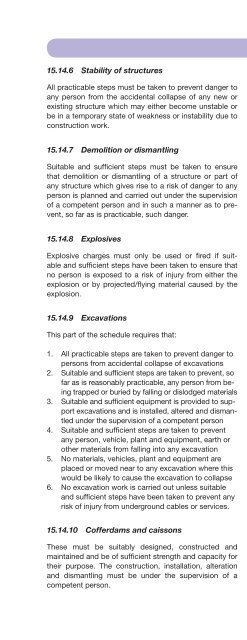Introduction to Fire Safety Management
Introduction to Fire Safety Management
Introduction to Fire Safety Management
Create successful ePaper yourself
Turn your PDF publications into a flip-book with our unique Google optimized e-Paper software.
15.14.6 Stability of structures<br />
All practicable steps must be taken <strong>to</strong> prevent danger <strong>to</strong><br />
any person from the accidental collapse of any new or<br />
existing structure which may either become unstable or<br />
be in a temporary state of weakness or instability due <strong>to</strong><br />
construction work.<br />
15.14.7 Demolition or dismantling<br />
Suitable and suffi cient steps must be taken <strong>to</strong> ensure<br />
that demolition or dismantling of a structure or part of<br />
any structure which gives rise <strong>to</strong> a risk of danger <strong>to</strong> any<br />
person is planned and carried out under the supervision<br />
of a competent person and in such a manner as <strong>to</strong> prevent,<br />
so far as is practicable, such danger.<br />
15.14.8 Explosives<br />
Explosive charges must only be used or fi red if suitable<br />
and suffi cient steps have been taken <strong>to</strong> ensure that<br />
no person is exposed <strong>to</strong> a risk of injury from either the<br />
explosion or by projected/fl ying material caused by the<br />
explosion.<br />
15.14.9 Excavations<br />
This part of the schedule requires that:<br />
1. All practicable steps are taken <strong>to</strong> prevent danger <strong>to</strong><br />
persons from accidental collapse of excavations<br />
2. Suitable and suffi cient steps are taken <strong>to</strong> prevent, so<br />
far as is reasonably practicable, any person from being<br />
trapped or buried by falling or dislodged materials<br />
3. Suitable and suffi cient equipment is provided <strong>to</strong> support<br />
excavations and is installed, altered and dismantled<br />
under the supervision of a competent person<br />
4. Suitable and suffi cient steps are taken <strong>to</strong> prevent<br />
any person, vehicle, plant and equipment, earth or<br />
other materials from falling in<strong>to</strong> any excavation<br />
5. No materials, vehicles, plant and equipment are<br />
placed or moved near <strong>to</strong> any excavation where this<br />
would be likely <strong>to</strong> cause the excavation <strong>to</strong> collapse<br />
6. No excavation work is carried out unless suitable<br />
and suffi cient steps have been taken <strong>to</strong> prevent any<br />
risk of injury from underground cables or services.<br />
15.14.10 Cofferdams and caissons<br />
These must be suitably designed, constructed and<br />
maintained and be of suffi cient strength and capacity for<br />
their purpose. The construction, installation, alteration<br />
and dismantling must be under the supervision of a<br />
competent person.<br />
Summary of key legal requirements<br />
15.14.11 Reports of inspections<br />
Places of work including scaffolds, excavations, cofferdams<br />
and caissons must be inspected by a competent<br />
person before persons fi rst use the place of work and at<br />
scheduled intervals <strong>to</strong> determine that they are safe.<br />
Reports of the inspections required under the<br />
schedules must be prepared by the competent person<br />
who carried out the inspection before the end of the<br />
working period and a copy provided <strong>to</strong> the duty holder<br />
within 24 hours. A copy of the report must also be<br />
retained on site.<br />
15.14.12 Energy distribution installations<br />
Where there is a risk of contact with power supply<br />
cables the power supply should be in the fi rst instance<br />
directed away from the area or isolated; where this<br />
cannot be undertaken, barriers, signs and rerouting of<br />
vehicle movements should be considered.<br />
15.14.13 Prevention of drowning<br />
Where any person is liable <strong>to</strong> fall in<strong>to</strong> water or other liquid<br />
with a risk of drowning, suitable and suffi cient steps<br />
must be taken <strong>to</strong> prevent, so far as is reasonably practicable,<br />
a person from falling; and <strong>to</strong> minimise risk of<br />
drowning if people fall. Suitable rescue equipment must<br />
also be provided and maintained.<br />
Where persons are conveyed <strong>to</strong> work by water,<br />
suitable and suffi cient steps must be taken <strong>to</strong> ensure<br />
their safe transport and the vessel used <strong>to</strong> convey them<br />
must be suitable, properly constructed and maintained.<br />
The vessel must be under the control of a competent<br />
person and not be overcrowded or overloaded.<br />
15.14.14 Traffi c routes<br />
Construction sites must be organised <strong>to</strong> ensure that,<br />
so far as is reasonably practicable, pedestrians and<br />
vehicles can move safely and without risks <strong>to</strong> health.<br />
In organising traffi c routes, the following requirements<br />
must be satisfi ed:<br />
1. Traffi c routes must be suitable for those using them,<br />
suffi cient in number, in suitable positions and of suffi<br />
cient size<br />
2. Pedestrians or vehicles must be able <strong>to</strong> use the traffi<br />
c route without causing danger <strong>to</strong> others near it<br />
3. Any doors or gates used by pedestrians which lead<br />
on<strong>to</strong> a vehicle traffi c route must enable the pedestrians<br />
<strong>to</strong> see any approaching vehicles from a safe<br />
position<br />
4. There must be suffi cient separation between vehicles<br />
and pedestrians where reasonably practicable<br />
365

















